Comprehensive Analysis of Contract and Negligence Law and Case Studies
VerifiedAdded on 2019/12/03
|13
|4017
|221
Report
AI Summary
This report provides a comprehensive analysis of contract and negligence law, covering essential elements such as offer, acceptance, and consideration. It explores different types of contracts, including unilateral, bilateral, and implied contracts, and examines the impact of contractual terms like conditions, warranties, and exclusion clauses. The report delves into case scenarios to illustrate the applicability of these principles, including the formation of contracts and the implications of breach of contract. Furthermore, it addresses negligence, discussing the concept of duty of care as established in Donoghue v Stevenson and the application of vicarious liability. The report offers advice on recovering losses in negligence cases and contrasts liability in tort with contractual liability, providing a thorough overview of the subject matter.

Aspects of
contract and
negligence
contract and
negligence
Paraphrase This Document
Need a fresh take? Get an instant paraphrase of this document with our AI Paraphraser
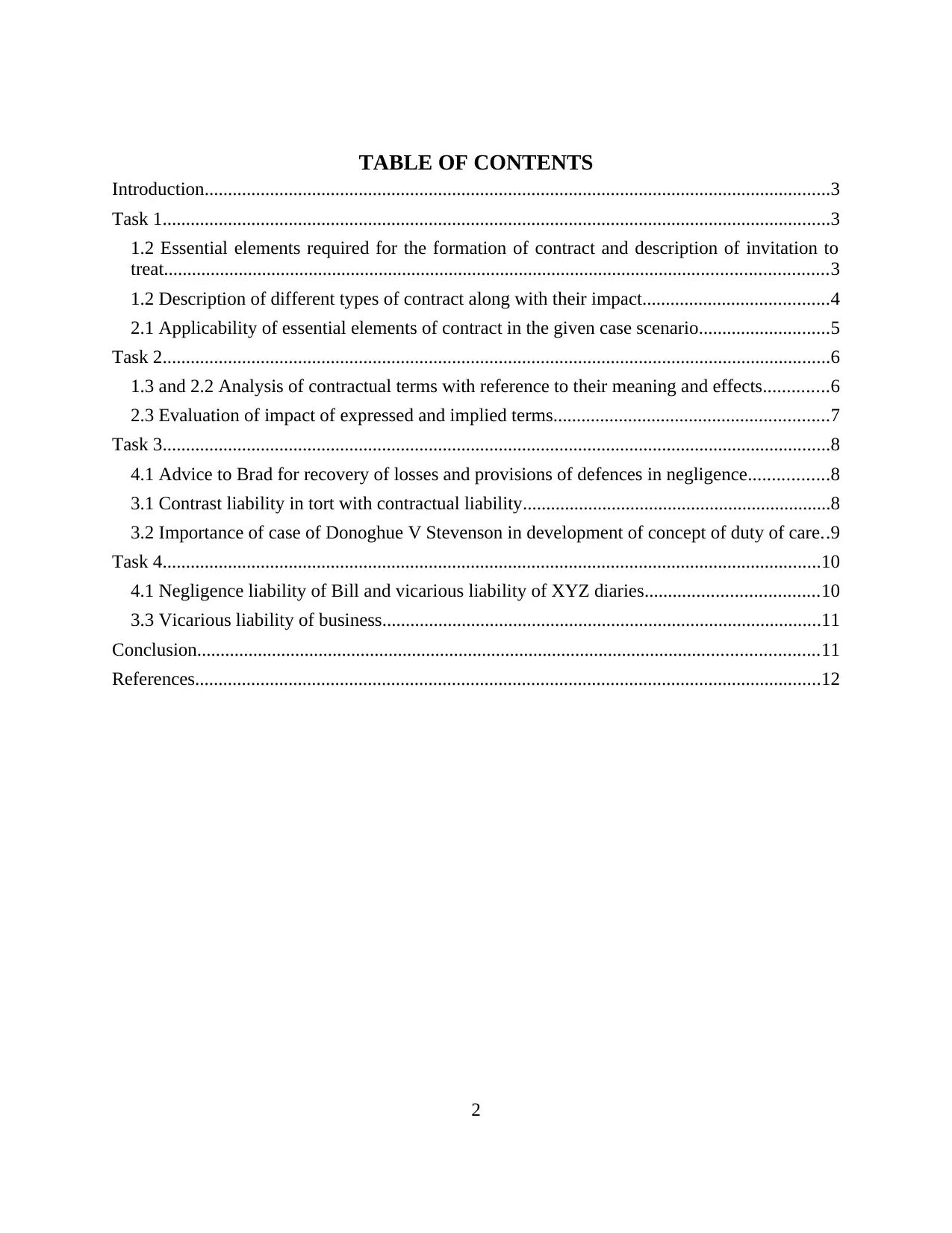
TABLE OF CONTENTS
Introduction......................................................................................................................................3
Task 1...............................................................................................................................................3
1.2 Essential elements required for the formation of contract and description of invitation to
treat..............................................................................................................................................3
1.2 Description of different types of contract along with their impact........................................4
2.1 Applicability of essential elements of contract in the given case scenario............................5
Task 2...............................................................................................................................................6
1.3 and 2.2 Analysis of contractual terms with reference to their meaning and effects..............6
2.3 Evaluation of impact of expressed and implied terms...........................................................7
Task 3...............................................................................................................................................8
4.1 Advice to Brad for recovery of losses and provisions of defences in negligence.................8
3.1 Contrast liability in tort with contractual liability..................................................................8
3.2 Importance of case of Donoghue V Stevenson in development of concept of duty of care..9
Task 4.............................................................................................................................................10
4.1 Negligence liability of Bill and vicarious liability of XYZ diaries.....................................10
3.3 Vicarious liability of business..............................................................................................11
Conclusion.....................................................................................................................................11
References......................................................................................................................................12
2
Introduction......................................................................................................................................3
Task 1...............................................................................................................................................3
1.2 Essential elements required for the formation of contract and description of invitation to
treat..............................................................................................................................................3
1.2 Description of different types of contract along with their impact........................................4
2.1 Applicability of essential elements of contract in the given case scenario............................5
Task 2...............................................................................................................................................6
1.3 and 2.2 Analysis of contractual terms with reference to their meaning and effects..............6
2.3 Evaluation of impact of expressed and implied terms...........................................................7
Task 3...............................................................................................................................................8
4.1 Advice to Brad for recovery of losses and provisions of defences in negligence.................8
3.1 Contrast liability in tort with contractual liability..................................................................8
3.2 Importance of case of Donoghue V Stevenson in development of concept of duty of care..9
Task 4.............................................................................................................................................10
4.1 Negligence liability of Bill and vicarious liability of XYZ diaries.....................................10
3.3 Vicarious liability of business..............................................................................................11
Conclusion.....................................................................................................................................11
References......................................................................................................................................12
2
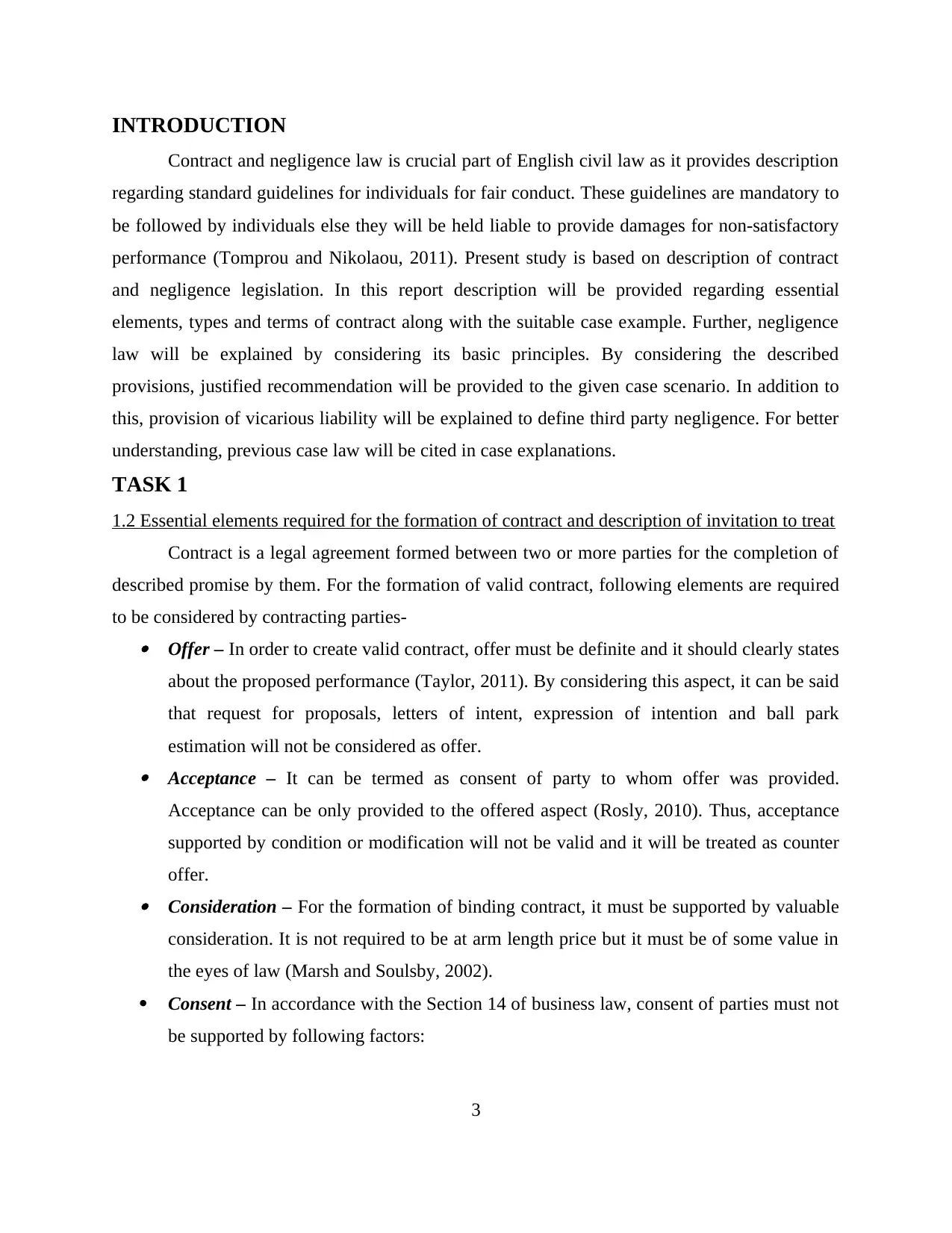
INTRODUCTION
Contract and negligence law is crucial part of English civil law as it provides description
regarding standard guidelines for individuals for fair conduct. These guidelines are mandatory to
be followed by individuals else they will be held liable to provide damages for non-satisfactory
performance (Tomprou and Nikolaou, 2011). Present study is based on description of contract
and negligence legislation. In this report description will be provided regarding essential
elements, types and terms of contract along with the suitable case example. Further, negligence
law will be explained by considering its basic principles. By considering the described
provisions, justified recommendation will be provided to the given case scenario. In addition to
this, provision of vicarious liability will be explained to define third party negligence. For better
understanding, previous case law will be cited in case explanations.
TASK 1
1.2 Essential elements required for the formation of contract and description of invitation to treat
Contract is a legal agreement formed between two or more parties for the completion of
described promise by them. For the formation of valid contract, following elements are required
to be considered by contracting parties- Offer – In order to create valid contract, offer must be definite and it should clearly states
about the proposed performance (Taylor, 2011). By considering this aspect, it can be said
that request for proposals, letters of intent, expression of intention and ball park
estimation will not be considered as offer. Acceptance – It can be termed as consent of party to whom offer was provided.
Acceptance can be only provided to the offered aspect (Rosly, 2010). Thus, acceptance
supported by condition or modification will not be valid and it will be treated as counter
offer. Consideration – For the formation of binding contract, it must be supported by valuable
consideration. It is not required to be at arm length price but it must be of some value in
the eyes of law (Marsh and Soulsby, 2002).
Consent – In accordance with the Section 14 of business law, consent of parties must not
be supported by following factors:
3
Contract and negligence law is crucial part of English civil law as it provides description
regarding standard guidelines for individuals for fair conduct. These guidelines are mandatory to
be followed by individuals else they will be held liable to provide damages for non-satisfactory
performance (Tomprou and Nikolaou, 2011). Present study is based on description of contract
and negligence legislation. In this report description will be provided regarding essential
elements, types and terms of contract along with the suitable case example. Further, negligence
law will be explained by considering its basic principles. By considering the described
provisions, justified recommendation will be provided to the given case scenario. In addition to
this, provision of vicarious liability will be explained to define third party negligence. For better
understanding, previous case law will be cited in case explanations.
TASK 1
1.2 Essential elements required for the formation of contract and description of invitation to treat
Contract is a legal agreement formed between two or more parties for the completion of
described promise by them. For the formation of valid contract, following elements are required
to be considered by contracting parties- Offer – In order to create valid contract, offer must be definite and it should clearly states
about the proposed performance (Taylor, 2011). By considering this aspect, it can be said
that request for proposals, letters of intent, expression of intention and ball park
estimation will not be considered as offer. Acceptance – It can be termed as consent of party to whom offer was provided.
Acceptance can be only provided to the offered aspect (Rosly, 2010). Thus, acceptance
supported by condition or modification will not be valid and it will be treated as counter
offer. Consideration – For the formation of binding contract, it must be supported by valuable
consideration. It is not required to be at arm length price but it must be of some value in
the eyes of law (Marsh and Soulsby, 2002).
Consent – In accordance with the Section 14 of business law, consent of parties must not
be supported by following factors:
3
⊘ This is a preview!⊘
Do you want full access?
Subscribe today to unlock all pages.

Trusted by 1+ million students worldwide
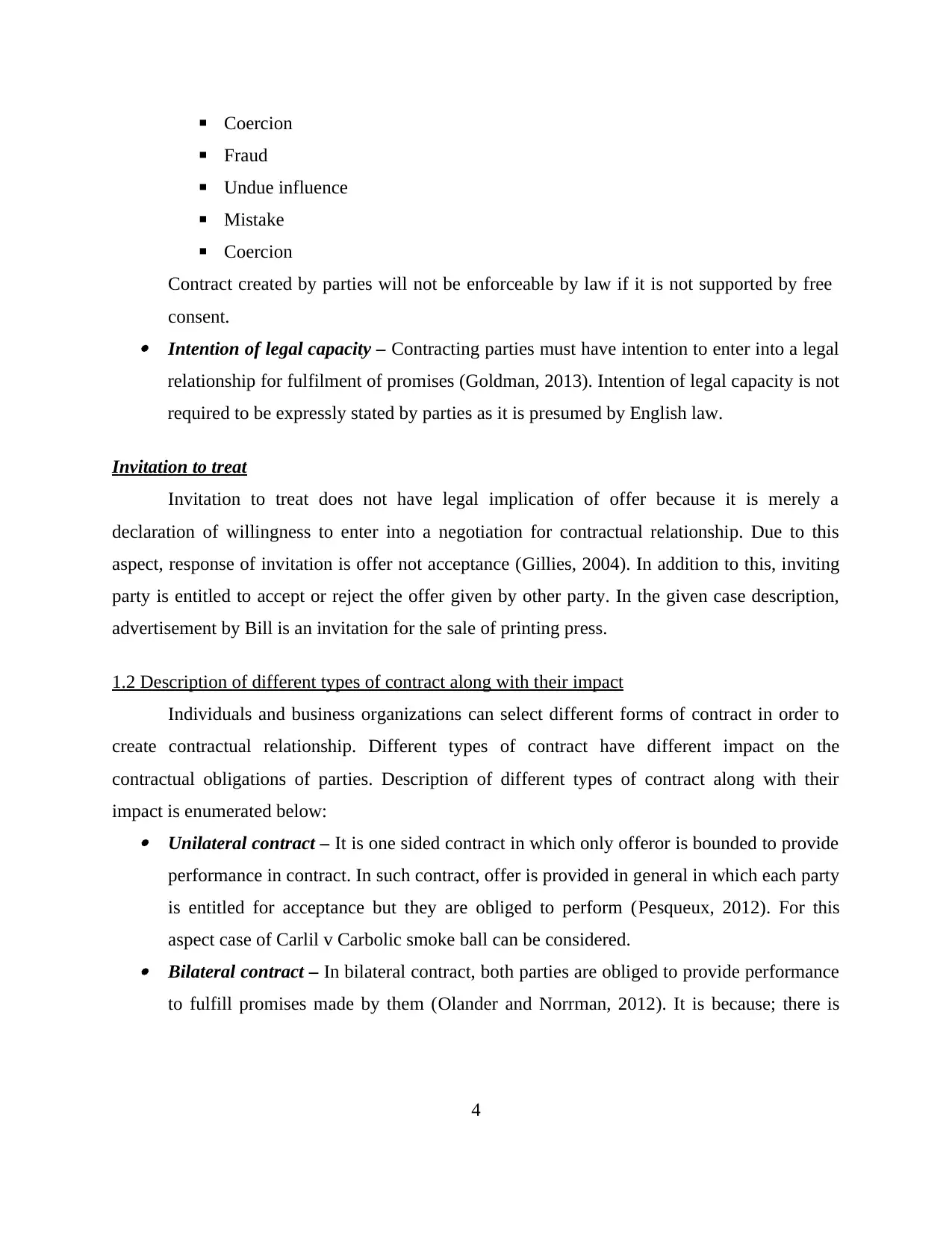
▪ Coercion
▪ Fraud
▪ Undue influence
▪ Mistake
▪ Coercion
Contract created by parties will not be enforceable by law if it is not supported by free
consent. Intention of legal capacity – Contracting parties must have intention to enter into a legal
relationship for fulfilment of promises (Goldman, 2013). Intention of legal capacity is not
required to be expressly stated by parties as it is presumed by English law.
Invitation to treat
Invitation to treat does not have legal implication of offer because it is merely a
declaration of willingness to enter into a negotiation for contractual relationship. Due to this
aspect, response of invitation is offer not acceptance (Gillies, 2004). In addition to this, inviting
party is entitled to accept or reject the offer given by other party. In the given case description,
advertisement by Bill is an invitation for the sale of printing press.
1.2 Description of different types of contract along with their impact
Individuals and business organizations can select different forms of contract in order to
create contractual relationship. Different types of contract have different impact on the
contractual obligations of parties. Description of different types of contract along with their
impact is enumerated below: Unilateral contract – It is one sided contract in which only offeror is bounded to provide
performance in contract. In such contract, offer is provided in general in which each party
is entitled for acceptance but they are obliged to perform (Pesqueux, 2012). For this
aspect case of Carlil v Carbolic smoke ball can be considered. Bilateral contract – In bilateral contract, both parties are obliged to provide performance
to fulfill promises made by them (Olander and Norrman, 2012). It is because; there is
4
▪ Fraud
▪ Undue influence
▪ Mistake
▪ Coercion
Contract created by parties will not be enforceable by law if it is not supported by free
consent. Intention of legal capacity – Contracting parties must have intention to enter into a legal
relationship for fulfilment of promises (Goldman, 2013). Intention of legal capacity is not
required to be expressly stated by parties as it is presumed by English law.
Invitation to treat
Invitation to treat does not have legal implication of offer because it is merely a
declaration of willingness to enter into a negotiation for contractual relationship. Due to this
aspect, response of invitation is offer not acceptance (Gillies, 2004). In addition to this, inviting
party is entitled to accept or reject the offer given by other party. In the given case description,
advertisement by Bill is an invitation for the sale of printing press.
1.2 Description of different types of contract along with their impact
Individuals and business organizations can select different forms of contract in order to
create contractual relationship. Different types of contract have different impact on the
contractual obligations of parties. Description of different types of contract along with their
impact is enumerated below: Unilateral contract – It is one sided contract in which only offeror is bounded to provide
performance in contract. In such contract, offer is provided in general in which each party
is entitled for acceptance but they are obliged to perform (Pesqueux, 2012). For this
aspect case of Carlil v Carbolic smoke ball can be considered. Bilateral contract – In bilateral contract, both parties are obliged to provide performance
to fulfill promises made by them (Olander and Norrman, 2012). It is because; there is
4
Paraphrase This Document
Need a fresh take? Get an instant paraphrase of this document with our AI Paraphraser
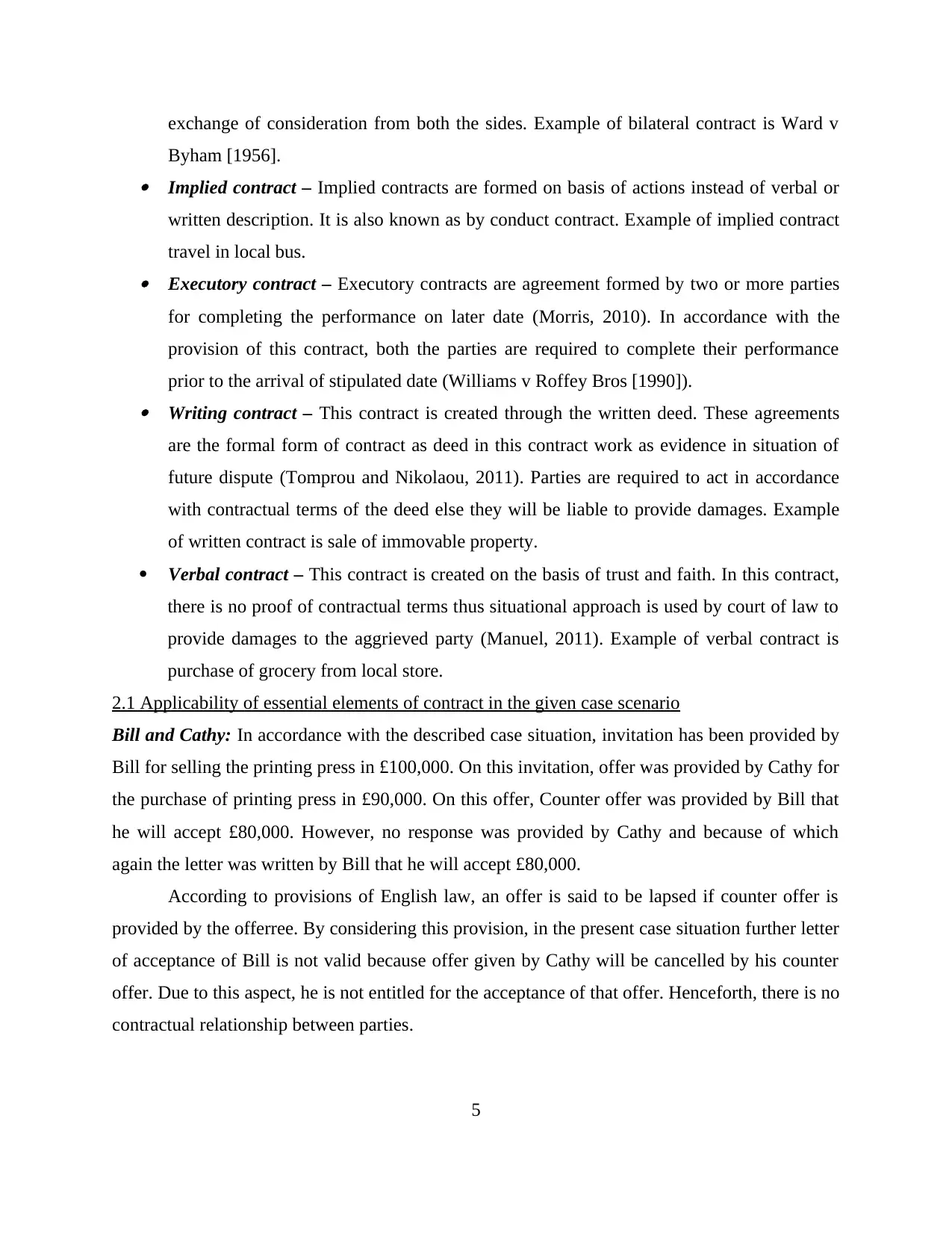
exchange of consideration from both the sides. Example of bilateral contract is Ward v
Byham [1956]. Implied contract – Implied contracts are formed on basis of actions instead of verbal or
written description. It is also known as by conduct contract. Example of implied contract
travel in local bus. Executory contract – Executory contracts are agreement formed by two or more parties
for completing the performance on later date (Morris, 2010). In accordance with the
provision of this contract, both the parties are required to complete their performance
prior to the arrival of stipulated date (Williams v Roffey Bros [1990]). Writing contract – This contract is created through the written deed. These agreements
are the formal form of contract as deed in this contract work as evidence in situation of
future dispute (Tomprou and Nikolaou, 2011). Parties are required to act in accordance
with contractual terms of the deed else they will be liable to provide damages. Example
of written contract is sale of immovable property.
Verbal contract – This contract is created on the basis of trust and faith. In this contract,
there is no proof of contractual terms thus situational approach is used by court of law to
provide damages to the aggrieved party (Manuel, 2011). Example of verbal contract is
purchase of grocery from local store.
2.1 Applicability of essential elements of contract in the given case scenario
Bill and Cathy: In accordance with the described case situation, invitation has been provided by
Bill for selling the printing press in £100,000. On this invitation, offer was provided by Cathy for
the purchase of printing press in £90,000. On this offer, Counter offer was provided by Bill that
he will accept £80,000. However, no response was provided by Cathy and because of which
again the letter was written by Bill that he will accept £80,000.
According to provisions of English law, an offer is said to be lapsed if counter offer is
provided by the offerree. By considering this provision, in the present case situation further letter
of acceptance of Bill is not valid because offer given by Cathy will be cancelled by his counter
offer. Due to this aspect, he is not entitled for the acceptance of that offer. Henceforth, there is no
contractual relationship between parties.
5
Byham [1956]. Implied contract – Implied contracts are formed on basis of actions instead of verbal or
written description. It is also known as by conduct contract. Example of implied contract
travel in local bus. Executory contract – Executory contracts are agreement formed by two or more parties
for completing the performance on later date (Morris, 2010). In accordance with the
provision of this contract, both the parties are required to complete their performance
prior to the arrival of stipulated date (Williams v Roffey Bros [1990]). Writing contract – This contract is created through the written deed. These agreements
are the formal form of contract as deed in this contract work as evidence in situation of
future dispute (Tomprou and Nikolaou, 2011). Parties are required to act in accordance
with contractual terms of the deed else they will be liable to provide damages. Example
of written contract is sale of immovable property.
Verbal contract – This contract is created on the basis of trust and faith. In this contract,
there is no proof of contractual terms thus situational approach is used by court of law to
provide damages to the aggrieved party (Manuel, 2011). Example of verbal contract is
purchase of grocery from local store.
2.1 Applicability of essential elements of contract in the given case scenario
Bill and Cathy: In accordance with the described case situation, invitation has been provided by
Bill for selling the printing press in £100,000. On this invitation, offer was provided by Cathy for
the purchase of printing press in £90,000. On this offer, Counter offer was provided by Bill that
he will accept £80,000. However, no response was provided by Cathy and because of which
again the letter was written by Bill that he will accept £80,000.
According to provisions of English law, an offer is said to be lapsed if counter offer is
provided by the offerree. By considering this provision, in the present case situation further letter
of acceptance of Bill is not valid because offer given by Cathy will be cancelled by his counter
offer. Due to this aspect, he is not entitled for the acceptance of that offer. Henceforth, there is no
contractual relationship between parties.
5
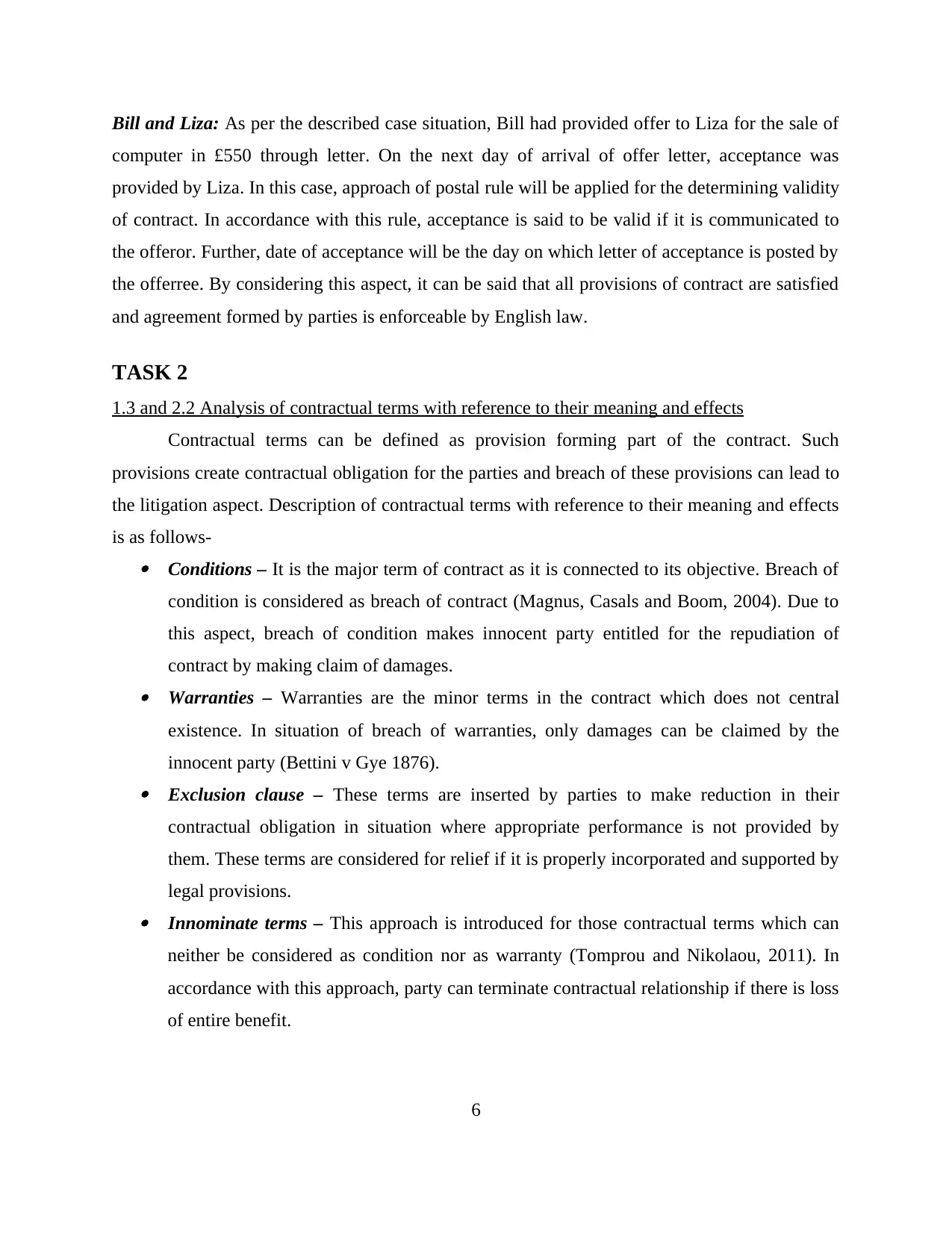
Bill and Liza: As per the described case situation, Bill had provided offer to Liza for the sale of
computer in £550 through letter. On the next day of arrival of offer letter, acceptance was
provided by Liza. In this case, approach of postal rule will be applied for the determining validity
of contract. In accordance with this rule, acceptance is said to be valid if it is communicated to
the offeror. Further, date of acceptance will be the day on which letter of acceptance is posted by
the offerree. By considering this aspect, it can be said that all provisions of contract are satisfied
and agreement formed by parties is enforceable by English law.
TASK 2
1.3 and 2.2 Analysis of contractual terms with reference to their meaning and effects
Contractual terms can be defined as provision forming part of the contract. Such
provisions create contractual obligation for the parties and breach of these provisions can lead to
the litigation aspect. Description of contractual terms with reference to their meaning and effects
is as follows- Conditions – It is the major term of contract as it is connected to its objective. Breach of
condition is considered as breach of contract (Magnus, Casals and Boom, 2004). Due to
this aspect, breach of condition makes innocent party entitled for the repudiation of
contract by making claim of damages. Warranties – Warranties are the minor terms in the contract which does not central
existence. In situation of breach of warranties, only damages can be claimed by the
innocent party (Bettini v Gye 1876). Exclusion clause – These terms are inserted by parties to make reduction in their
contractual obligation in situation where appropriate performance is not provided by
them. These terms are considered for relief if it is properly incorporated and supported by
legal provisions. Innominate terms – This approach is introduced for those contractual terms which can
neither be considered as condition nor as warranty (Tomprou and Nikolaou, 2011). In
accordance with this approach, party can terminate contractual relationship if there is loss
of entire benefit.
6
computer in £550 through letter. On the next day of arrival of offer letter, acceptance was
provided by Liza. In this case, approach of postal rule will be applied for the determining validity
of contract. In accordance with this rule, acceptance is said to be valid if it is communicated to
the offeror. Further, date of acceptance will be the day on which letter of acceptance is posted by
the offerree. By considering this aspect, it can be said that all provisions of contract are satisfied
and agreement formed by parties is enforceable by English law.
TASK 2
1.3 and 2.2 Analysis of contractual terms with reference to their meaning and effects
Contractual terms can be defined as provision forming part of the contract. Such
provisions create contractual obligation for the parties and breach of these provisions can lead to
the litigation aspect. Description of contractual terms with reference to their meaning and effects
is as follows- Conditions – It is the major term of contract as it is connected to its objective. Breach of
condition is considered as breach of contract (Magnus, Casals and Boom, 2004). Due to
this aspect, breach of condition makes innocent party entitled for the repudiation of
contract by making claim of damages. Warranties – Warranties are the minor terms in the contract which does not central
existence. In situation of breach of warranties, only damages can be claimed by the
innocent party (Bettini v Gye 1876). Exclusion clause – These terms are inserted by parties to make reduction in their
contractual obligation in situation where appropriate performance is not provided by
them. These terms are considered for relief if it is properly incorporated and supported by
legal provisions. Innominate terms – This approach is introduced for those contractual terms which can
neither be considered as condition nor as warranty (Tomprou and Nikolaou, 2011). In
accordance with this approach, party can terminate contractual relationship if there is loss
of entire benefit.
6
⊘ This is a preview!⊘
Do you want full access?
Subscribe today to unlock all pages.

Trusted by 1+ million students worldwide

Case scenario
In the described case situation, Opera singer Joyce DiDonato has been terminated from
two employment contracts consequently by her employers due to poor heath. Initial employment
contract was terminated because Joyce DiDonato had missed first four nights of the main
performance due to which she was replaced by another opera singer by The Royal Albert
Company. Second employment contract was terminated because she was not able to attend
rehearsals and again her employer replaced her with the another singer.
For this situation, case of Poussard v Spiers (1876) 1 QBD 410 can be considered. In
accordance with this case, innocent party is entitled for the termination of contract only if
conditions are breached. By considering this aspect, it can be said termination of employment
contract by The Royal Albert Company is fair because Joyce DiDonato had breach the condition.
However, second termination of employment contract is not fair because absence from rehearsals
will be considered as breach of warranty.
2.3 Evaluation of impact of expressed and implied terms
Nature of contractual terms can be expressed or implied. Expressed terms are inserted by
the consent of parties in contractual deed. These terms can be bifurcated into conditions,
warranties and innominate terms. On the other hand, implied terms are assumed to be part of the
contractual deed because these are not expressly stated (Lockwood, 2011). These terms are
inserted by statue, custom and court of law from the objective to provide protection to the
weaker party from unfair terms. Impact of expressed and implied terms can be considered
through following case situations:
Case scenario 1 (expressed terms): In the given case situation, there was agreement between
Scammell and Outson for the supply of Van on hire purchase terms. With this agreement, Outson
was proposed to earn £100 but due to disagreement he lost this opportunity. In this case
description, there is breach of expressed terms. Due to this aspect, Outson is entitled to make
claim for opportunity loss due to disagreement from Scammell.
Case scenario 2 (implied terms): According to the described case scenario, there was tenancy
agreement between farmer and landlord. In this case, farmer had planter corn and barley on the
7
In the described case situation, Opera singer Joyce DiDonato has been terminated from
two employment contracts consequently by her employers due to poor heath. Initial employment
contract was terminated because Joyce DiDonato had missed first four nights of the main
performance due to which she was replaced by another opera singer by The Royal Albert
Company. Second employment contract was terminated because she was not able to attend
rehearsals and again her employer replaced her with the another singer.
For this situation, case of Poussard v Spiers (1876) 1 QBD 410 can be considered. In
accordance with this case, innocent party is entitled for the termination of contract only if
conditions are breached. By considering this aspect, it can be said termination of employment
contract by The Royal Albert Company is fair because Joyce DiDonato had breach the condition.
However, second termination of employment contract is not fair because absence from rehearsals
will be considered as breach of warranty.
2.3 Evaluation of impact of expressed and implied terms
Nature of contractual terms can be expressed or implied. Expressed terms are inserted by
the consent of parties in contractual deed. These terms can be bifurcated into conditions,
warranties and innominate terms. On the other hand, implied terms are assumed to be part of the
contractual deed because these are not expressly stated (Lockwood, 2011). These terms are
inserted by statue, custom and court of law from the objective to provide protection to the
weaker party from unfair terms. Impact of expressed and implied terms can be considered
through following case situations:
Case scenario 1 (expressed terms): In the given case situation, there was agreement between
Scammell and Outson for the supply of Van on hire purchase terms. With this agreement, Outson
was proposed to earn £100 but due to disagreement he lost this opportunity. In this case
description, there is breach of expressed terms. Due to this aspect, Outson is entitled to make
claim for opportunity loss due to disagreement from Scammell.
Case scenario 2 (implied terms): According to the described case scenario, there was tenancy
agreement between farmer and landlord. In this case, farmer had planter corn and barley on the
7
Paraphrase This Document
Need a fresh take? Get an instant paraphrase of this document with our AI Paraphraser
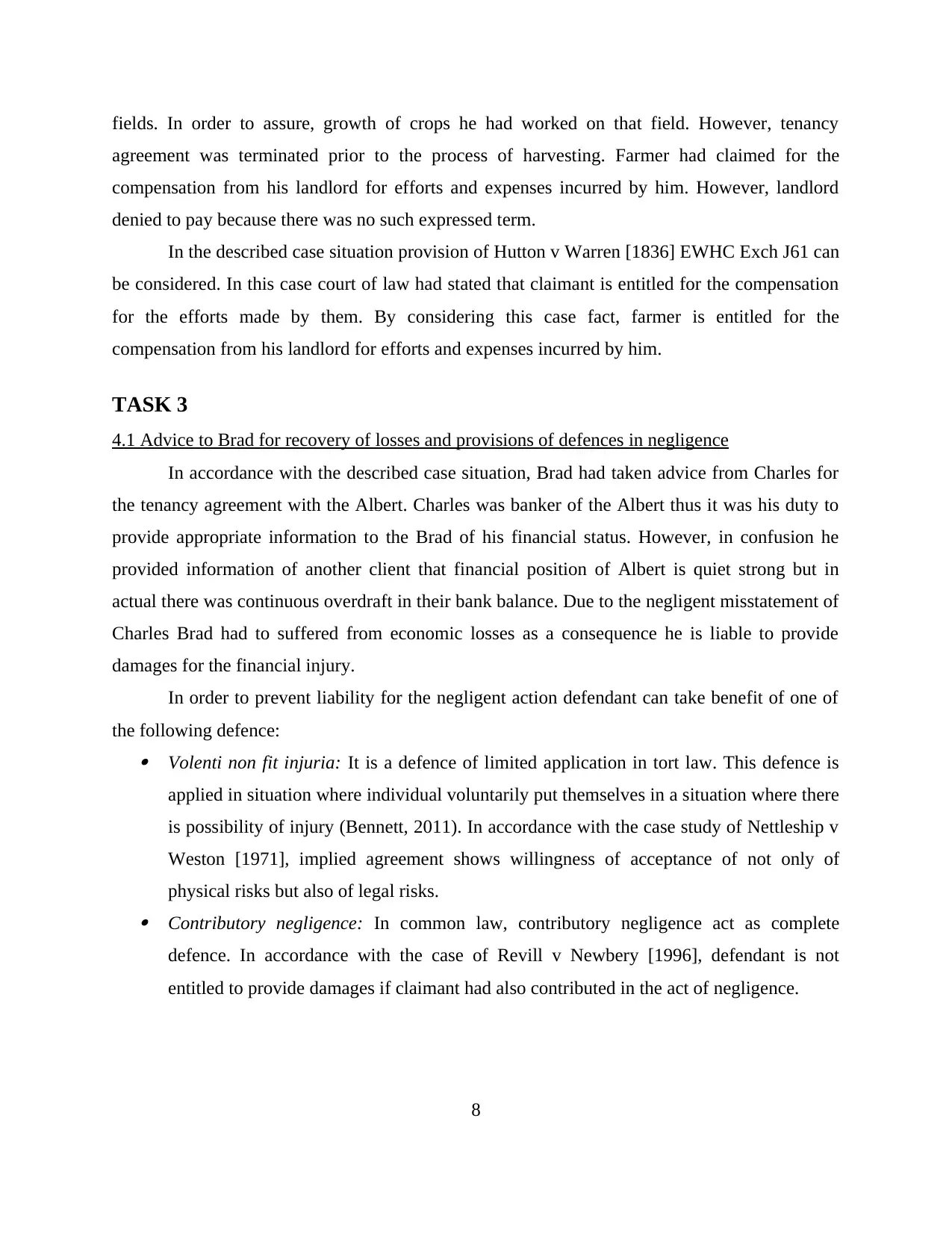
fields. In order to assure, growth of crops he had worked on that field. However, tenancy
agreement was terminated prior to the process of harvesting. Farmer had claimed for the
compensation from his landlord for efforts and expenses incurred by him. However, landlord
denied to pay because there was no such expressed term.
In the described case situation provision of Hutton v Warren [1836] EWHC Exch J61 can
be considered. In this case court of law had stated that claimant is entitled for the compensation
for the efforts made by them. By considering this case fact, farmer is entitled for the
compensation from his landlord for efforts and expenses incurred by him.
TASK 3
4.1 Advice to Brad for recovery of losses and provisions of defences in negligence
In accordance with the described case situation, Brad had taken advice from Charles for
the tenancy agreement with the Albert. Charles was banker of the Albert thus it was his duty to
provide appropriate information to the Brad of his financial status. However, in confusion he
provided information of another client that financial position of Albert is quiet strong but in
actual there was continuous overdraft in their bank balance. Due to the negligent misstatement of
Charles Brad had to suffered from economic losses as a consequence he is liable to provide
damages for the financial injury.
In order to prevent liability for the negligent action defendant can take benefit of one of
the following defence: Volenti non fit injuria: It is a defence of limited application in tort law. This defence is
applied in situation where individual voluntarily put themselves in a situation where there
is possibility of injury (Bennett, 2011). In accordance with the case study of Nettleship v
Weston [1971], implied agreement shows willingness of acceptance of not only of
physical risks but also of legal risks. Contributory negligence: In common law, contributory negligence act as complete
defence. In accordance with the case of Revill v Newbery [1996], defendant is not
entitled to provide damages if claimant had also contributed in the act of negligence.
8
agreement was terminated prior to the process of harvesting. Farmer had claimed for the
compensation from his landlord for efforts and expenses incurred by him. However, landlord
denied to pay because there was no such expressed term.
In the described case situation provision of Hutton v Warren [1836] EWHC Exch J61 can
be considered. In this case court of law had stated that claimant is entitled for the compensation
for the efforts made by them. By considering this case fact, farmer is entitled for the
compensation from his landlord for efforts and expenses incurred by him.
TASK 3
4.1 Advice to Brad for recovery of losses and provisions of defences in negligence
In accordance with the described case situation, Brad had taken advice from Charles for
the tenancy agreement with the Albert. Charles was banker of the Albert thus it was his duty to
provide appropriate information to the Brad of his financial status. However, in confusion he
provided information of another client that financial position of Albert is quiet strong but in
actual there was continuous overdraft in their bank balance. Due to the negligent misstatement of
Charles Brad had to suffered from economic losses as a consequence he is liable to provide
damages for the financial injury.
In order to prevent liability for the negligent action defendant can take benefit of one of
the following defence: Volenti non fit injuria: It is a defence of limited application in tort law. This defence is
applied in situation where individual voluntarily put themselves in a situation where there
is possibility of injury (Bennett, 2011). In accordance with the case study of Nettleship v
Weston [1971], implied agreement shows willingness of acceptance of not only of
physical risks but also of legal risks. Contributory negligence: In common law, contributory negligence act as complete
defence. In accordance with the case of Revill v Newbery [1996], defendant is not
entitled to provide damages if claimant had also contributed in the act of negligence.
8
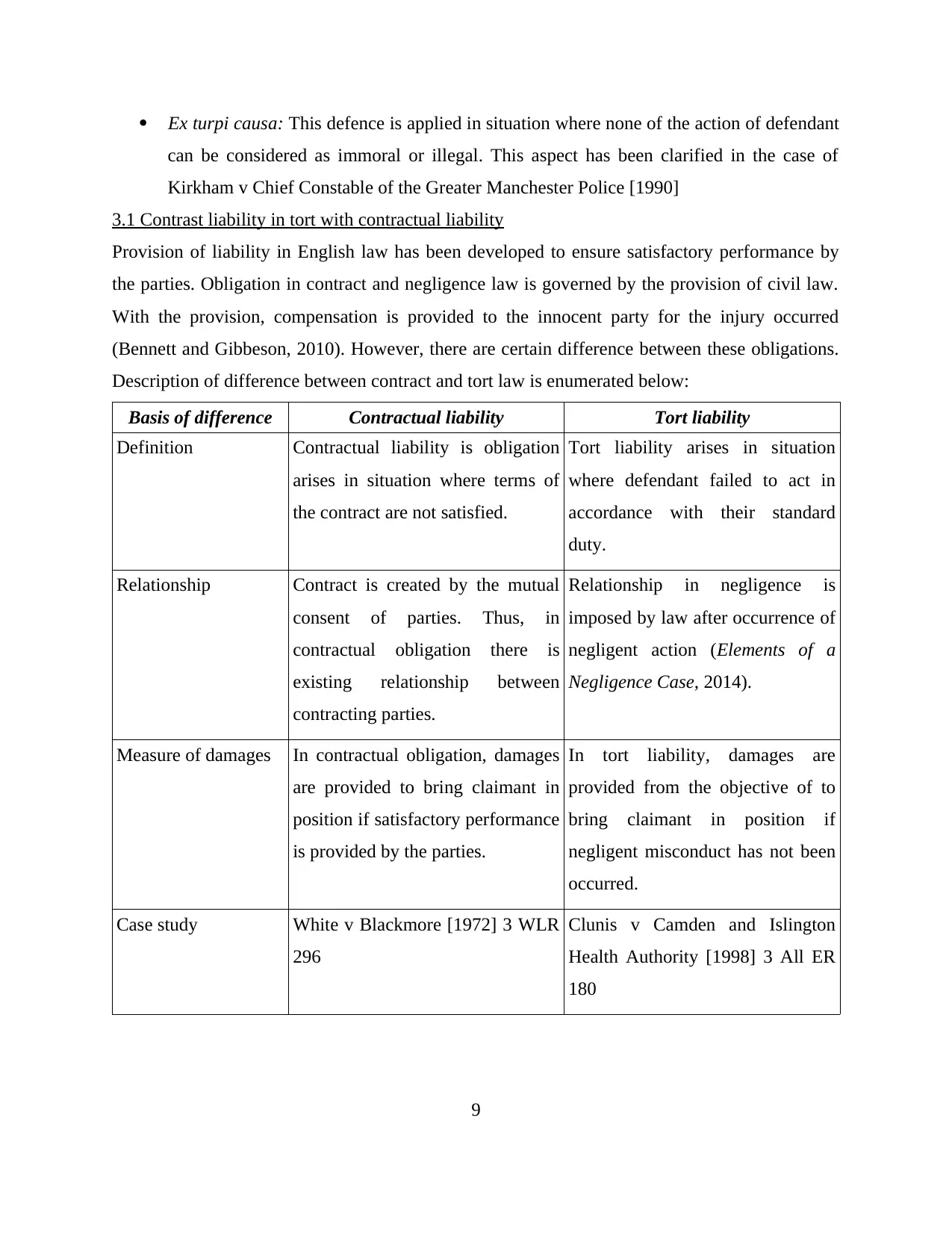
Ex turpi causa: This defence is applied in situation where none of the action of defendant
can be considered as immoral or illegal. This aspect has been clarified in the case of
Kirkham v Chief Constable of the Greater Manchester Police [1990]
3.1 Contrast liability in tort with contractual liability
Provision of liability in English law has been developed to ensure satisfactory performance by
the parties. Obligation in contract and negligence law is governed by the provision of civil law.
With the provision, compensation is provided to the innocent party for the injury occurred
(Bennett and Gibbeson, 2010). However, there are certain difference between these obligations.
Description of difference between contract and tort law is enumerated below:
Basis of difference Contractual liability Tort liability
Definition Contractual liability is obligation
arises in situation where terms of
the contract are not satisfied.
Tort liability arises in situation
where defendant failed to act in
accordance with their standard
duty.
Relationship Contract is created by the mutual
consent of parties. Thus, in
contractual obligation there is
existing relationship between
contracting parties.
Relationship in negligence is
imposed by law after occurrence of
negligent action (Elements of a
Negligence Case, 2014).
Measure of damages In contractual obligation, damages
are provided to bring claimant in
position if satisfactory performance
is provided by the parties.
In tort liability, damages are
provided from the objective of to
bring claimant in position if
negligent misconduct has not been
occurred.
Case study White v Blackmore [1972] 3 WLR
296
Clunis v Camden and Islington
Health Authority [1998] 3 All ER
180
9
can be considered as immoral or illegal. This aspect has been clarified in the case of
Kirkham v Chief Constable of the Greater Manchester Police [1990]
3.1 Contrast liability in tort with contractual liability
Provision of liability in English law has been developed to ensure satisfactory performance by
the parties. Obligation in contract and negligence law is governed by the provision of civil law.
With the provision, compensation is provided to the innocent party for the injury occurred
(Bennett and Gibbeson, 2010). However, there are certain difference between these obligations.
Description of difference between contract and tort law is enumerated below:
Basis of difference Contractual liability Tort liability
Definition Contractual liability is obligation
arises in situation where terms of
the contract are not satisfied.
Tort liability arises in situation
where defendant failed to act in
accordance with their standard
duty.
Relationship Contract is created by the mutual
consent of parties. Thus, in
contractual obligation there is
existing relationship between
contracting parties.
Relationship in negligence is
imposed by law after occurrence of
negligent action (Elements of a
Negligence Case, 2014).
Measure of damages In contractual obligation, damages
are provided to bring claimant in
position if satisfactory performance
is provided by the parties.
In tort liability, damages are
provided from the objective of to
bring claimant in position if
negligent misconduct has not been
occurred.
Case study White v Blackmore [1972] 3 WLR
296
Clunis v Camden and Islington
Health Authority [1998] 3 All ER
180
9
⊘ This is a preview!⊘
Do you want full access?
Subscribe today to unlock all pages.

Trusted by 1+ million students worldwide
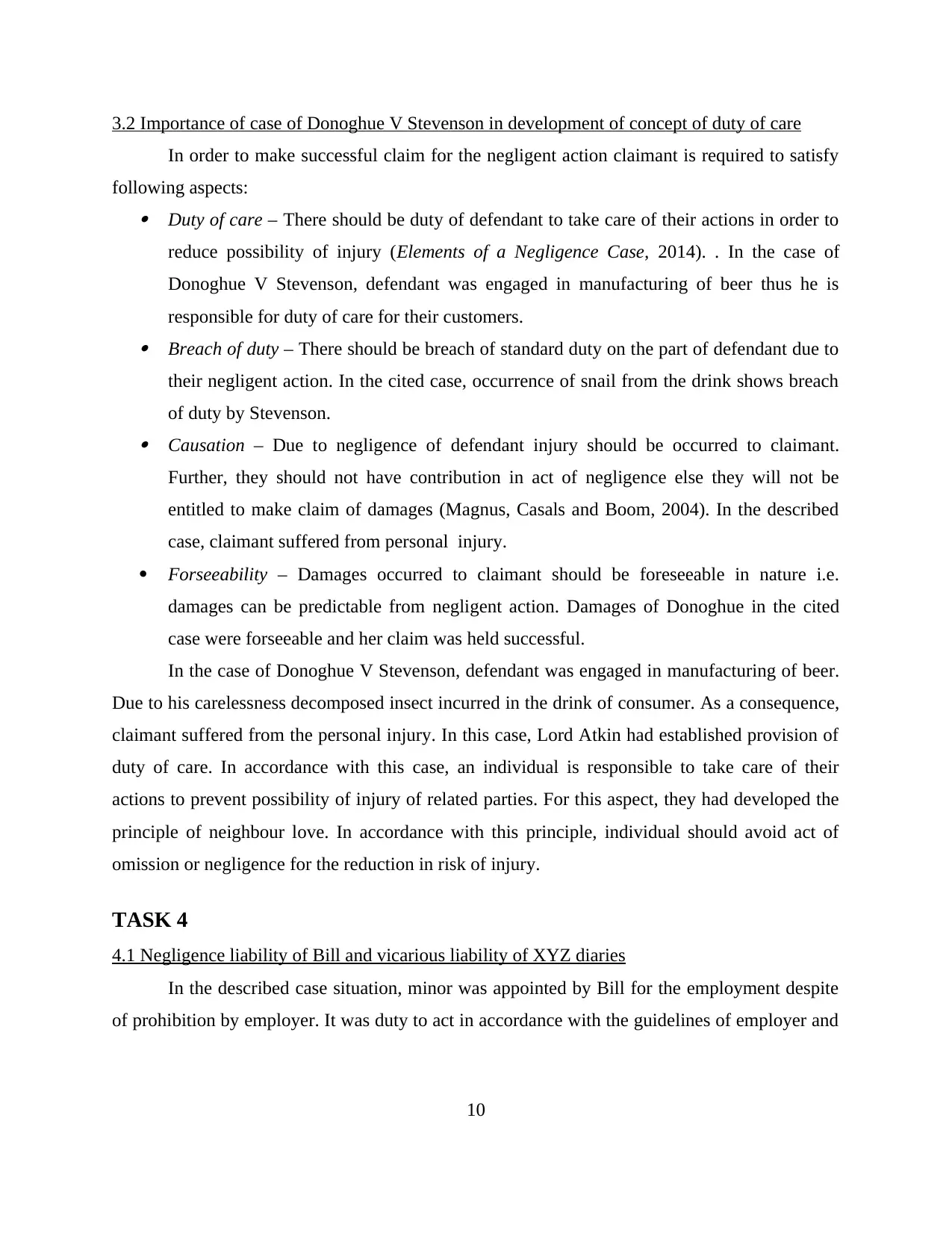
3.2 Importance of case of Donoghue V Stevenson in development of concept of duty of care
In order to make successful claim for the negligent action claimant is required to satisfy
following aspects: Duty of care – There should be duty of defendant to take care of their actions in order to
reduce possibility of injury (Elements of a Negligence Case, 2014). . In the case of
Donoghue V Stevenson, defendant was engaged in manufacturing of beer thus he is
responsible for duty of care for their customers. Breach of duty – There should be breach of standard duty on the part of defendant due to
their negligent action. In the cited case, occurrence of snail from the drink shows breach
of duty by Stevenson. Causation – Due to negligence of defendant injury should be occurred to claimant.
Further, they should not have contribution in act of negligence else they will not be
entitled to make claim of damages (Magnus, Casals and Boom, 2004). In the described
case, claimant suffered from personal injury.
Forseeability – Damages occurred to claimant should be foreseeable in nature i.e.
damages can be predictable from negligent action. Damages of Donoghue in the cited
case were forseeable and her claim was held successful.
In the case of Donoghue V Stevenson, defendant was engaged in manufacturing of beer.
Due to his carelessness decomposed insect incurred in the drink of consumer. As a consequence,
claimant suffered from the personal injury. In this case, Lord Atkin had established provision of
duty of care. In accordance with this case, an individual is responsible to take care of their
actions to prevent possibility of injury of related parties. For this aspect, they had developed the
principle of neighbour love. In accordance with this principle, individual should avoid act of
omission or negligence for the reduction in risk of injury.
TASK 4
4.1 Negligence liability of Bill and vicarious liability of XYZ diaries
In the described case situation, minor was appointed by Bill for the employment despite
of prohibition by employer. It was duty to act in accordance with the guidelines of employer and
10
In order to make successful claim for the negligent action claimant is required to satisfy
following aspects: Duty of care – There should be duty of defendant to take care of their actions in order to
reduce possibility of injury (Elements of a Negligence Case, 2014). . In the case of
Donoghue V Stevenson, defendant was engaged in manufacturing of beer thus he is
responsible for duty of care for their customers. Breach of duty – There should be breach of standard duty on the part of defendant due to
their negligent action. In the cited case, occurrence of snail from the drink shows breach
of duty by Stevenson. Causation – Due to negligence of defendant injury should be occurred to claimant.
Further, they should not have contribution in act of negligence else they will not be
entitled to make claim of damages (Magnus, Casals and Boom, 2004). In the described
case, claimant suffered from personal injury.
Forseeability – Damages occurred to claimant should be foreseeable in nature i.e.
damages can be predictable from negligent action. Damages of Donoghue in the cited
case were forseeable and her claim was held successful.
In the case of Donoghue V Stevenson, defendant was engaged in manufacturing of beer.
Due to his carelessness decomposed insect incurred in the drink of consumer. As a consequence,
claimant suffered from the personal injury. In this case, Lord Atkin had established provision of
duty of care. In accordance with this case, an individual is responsible to take care of their
actions to prevent possibility of injury of related parties. For this aspect, they had developed the
principle of neighbour love. In accordance with this principle, individual should avoid act of
omission or negligence for the reduction in risk of injury.
TASK 4
4.1 Negligence liability of Bill and vicarious liability of XYZ diaries
In the described case situation, minor was appointed by Bill for the employment despite
of prohibition by employer. It was duty to act in accordance with the guidelines of employer and
10
Paraphrase This Document
Need a fresh take? Get an instant paraphrase of this document with our AI Paraphraser
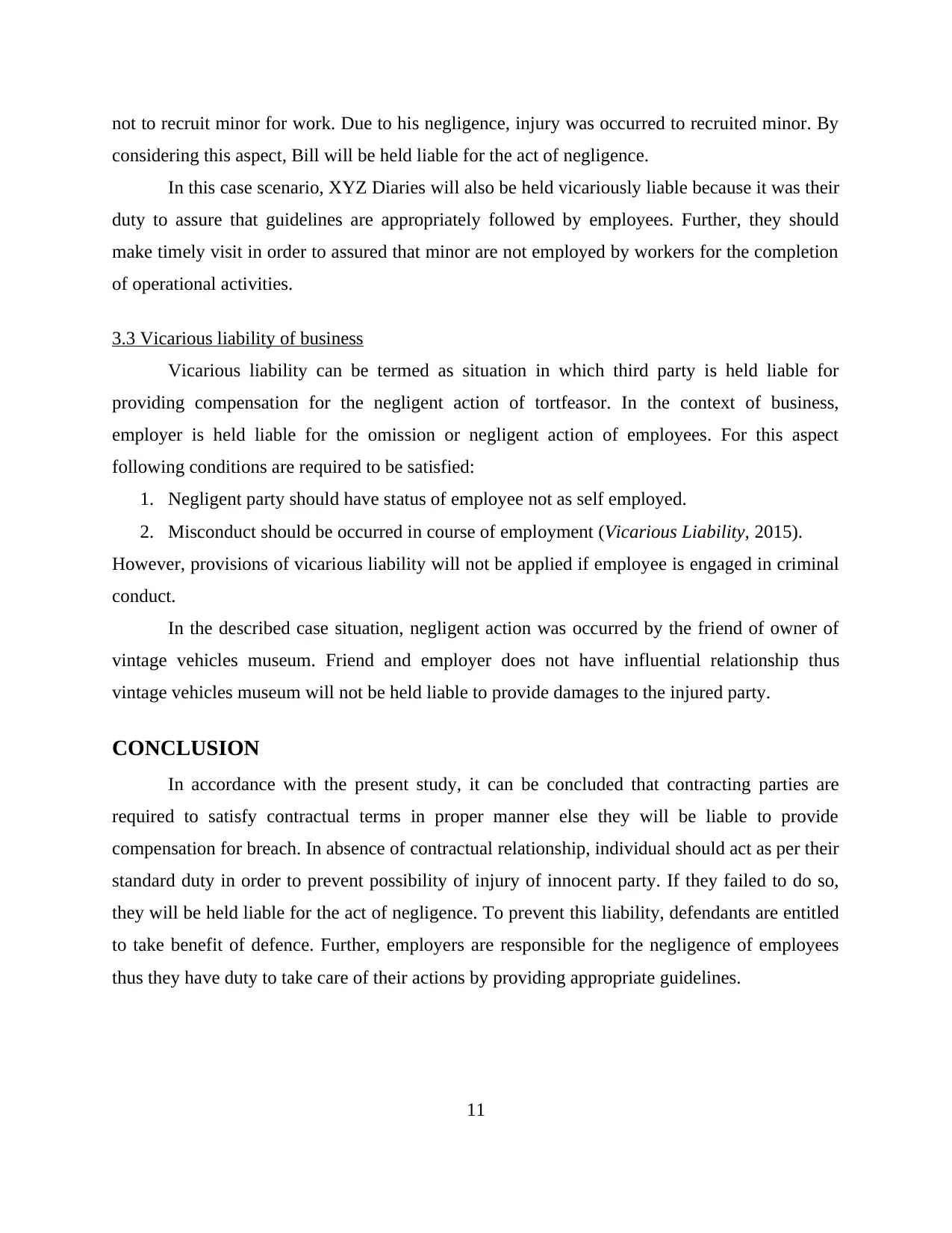
not to recruit minor for work. Due to his negligence, injury was occurred to recruited minor. By
considering this aspect, Bill will be held liable for the act of negligence.
In this case scenario, XYZ Diaries will also be held vicariously liable because it was their
duty to assure that guidelines are appropriately followed by employees. Further, they should
make timely visit in order to assured that minor are not employed by workers for the completion
of operational activities.
3.3 Vicarious liability of business
Vicarious liability can be termed as situation in which third party is held liable for
providing compensation for the negligent action of tortfeasor. In the context of business,
employer is held liable for the omission or negligent action of employees. For this aspect
following conditions are required to be satisfied:
1. Negligent party should have status of employee not as self employed.
2. Misconduct should be occurred in course of employment (Vicarious Liability, 2015).
However, provisions of vicarious liability will not be applied if employee is engaged in criminal
conduct.
In the described case situation, negligent action was occurred by the friend of owner of
vintage vehicles museum. Friend and employer does not have influential relationship thus
vintage vehicles museum will not be held liable to provide damages to the injured party.
CONCLUSION
In accordance with the present study, it can be concluded that contracting parties are
required to satisfy contractual terms in proper manner else they will be liable to provide
compensation for breach. In absence of contractual relationship, individual should act as per their
standard duty in order to prevent possibility of injury of innocent party. If they failed to do so,
they will be held liable for the act of negligence. To prevent this liability, defendants are entitled
to take benefit of defence. Further, employers are responsible for the negligence of employees
thus they have duty to take care of their actions by providing appropriate guidelines.
11
considering this aspect, Bill will be held liable for the act of negligence.
In this case scenario, XYZ Diaries will also be held vicariously liable because it was their
duty to assure that guidelines are appropriately followed by employees. Further, they should
make timely visit in order to assured that minor are not employed by workers for the completion
of operational activities.
3.3 Vicarious liability of business
Vicarious liability can be termed as situation in which third party is held liable for
providing compensation for the negligent action of tortfeasor. In the context of business,
employer is held liable for the omission or negligent action of employees. For this aspect
following conditions are required to be satisfied:
1. Negligent party should have status of employee not as self employed.
2. Misconduct should be occurred in course of employment (Vicarious Liability, 2015).
However, provisions of vicarious liability will not be applied if employee is engaged in criminal
conduct.
In the described case situation, negligent action was occurred by the friend of owner of
vintage vehicles museum. Friend and employer does not have influential relationship thus
vintage vehicles museum will not be held liable to provide damages to the injured party.
CONCLUSION
In accordance with the present study, it can be concluded that contracting parties are
required to satisfy contractual terms in proper manner else they will be liable to provide
compensation for breach. In absence of contractual relationship, individual should act as per their
standard duty in order to prevent possibility of injury of innocent party. If they failed to do so,
they will be held liable for the act of negligence. To prevent this liability, defendants are entitled
to take benefit of defence. Further, employers are responsible for the negligence of employees
thus they have duty to take care of their actions by providing appropriate guidelines.
11
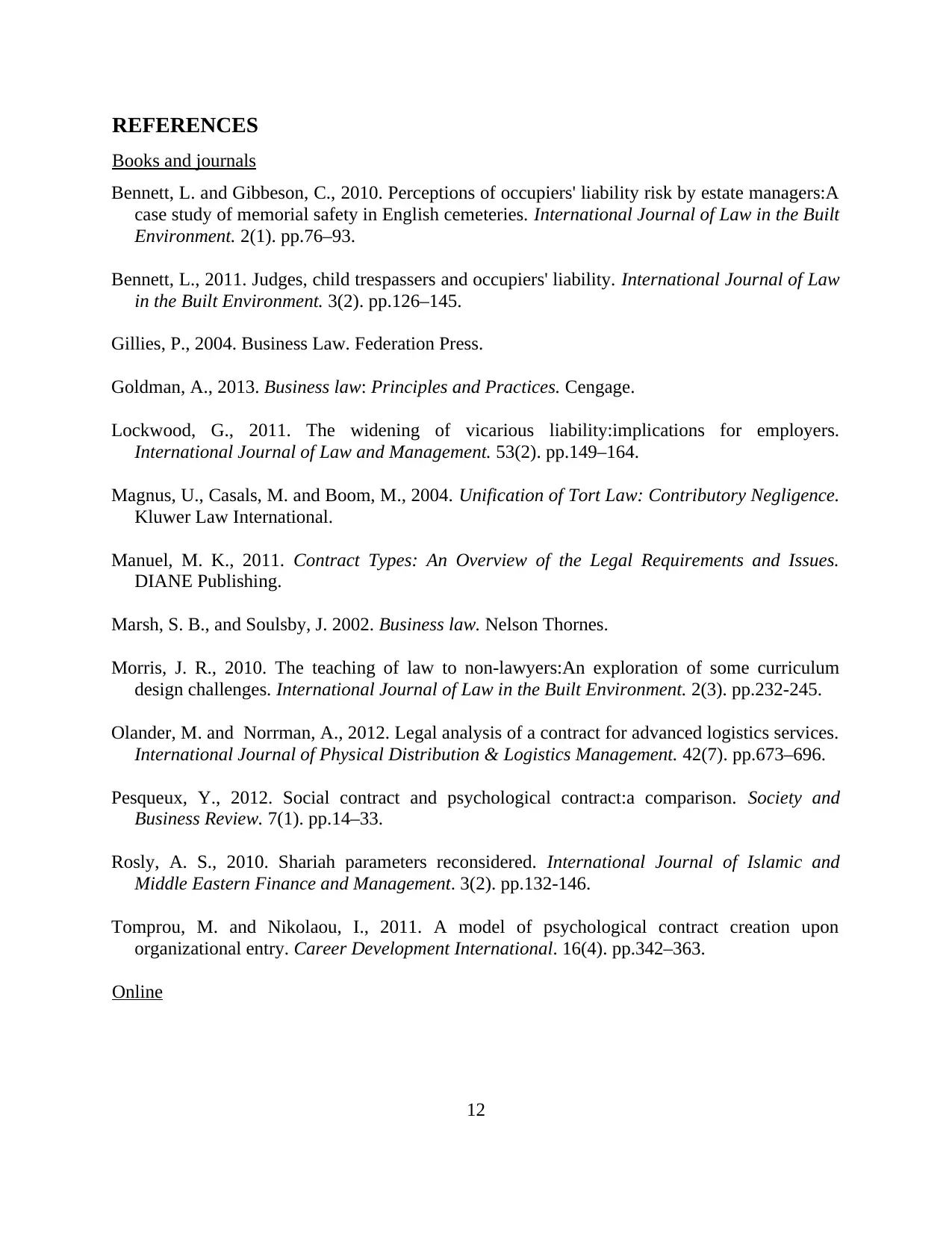
REFERENCES
Books and journals
Bennett, L. and Gibbeson, C., 2010. Perceptions of occupiers' liability risk by estate managers:A
case study of memorial safety in English cemeteries. International Journal of Law in the Built
Environment. 2(1). pp.76–93.
Bennett, L., 2011. Judges, child trespassers and occupiers' liability. International Journal of Law
in the Built Environment. 3(2). pp.126–145.
Gillies, P., 2004. Business Law. Federation Press.
Goldman, A., 2013. Business law: Principles and Practices. Cengage.
Lockwood, G., 2011. The widening of vicarious liability:implications for employers.
International Journal of Law and Management. 53(2). pp.149–164.
Magnus, U., Casals, M. and Boom, M., 2004. Unification of Tort Law: Contributory Negligence.
Kluwer Law International.
Manuel, M. K., 2011. Contract Types: An Overview of the Legal Requirements and Issues.
DIANE Publishing.
Marsh, S. B., and Soulsby, J. 2002. Business law. Nelson Thornes.
Morris, J. R., 2010. The teaching of law to non‐lawyers:An exploration of some curriculum
design challenges. International Journal of Law in the Built Environment. 2(3). pp.232-245.
Olander, M. and Norrman, A., 2012. Legal analysis of a contract for advanced logistics services.
International Journal of Physical Distribution & Logistics Management. 42(7). pp.673–696.
Pesqueux, Y., 2012. Social contract and psychological contract:a comparison. Society and
Business Review. 7(1). pp.14–33.
Rosly, A. S., 2010. Shariah parameters reconsidered. International Journal of Islamic and
Middle Eastern Finance and Management. 3(2). pp.132-146.
Tomprou, M. and Nikolaou, I., 2011. A model of psychological contract creation upon
organizational entry. Career Development International. 16(4). pp.342–363.
Online
12
Books and journals
Bennett, L. and Gibbeson, C., 2010. Perceptions of occupiers' liability risk by estate managers:A
case study of memorial safety in English cemeteries. International Journal of Law in the Built
Environment. 2(1). pp.76–93.
Bennett, L., 2011. Judges, child trespassers and occupiers' liability. International Journal of Law
in the Built Environment. 3(2). pp.126–145.
Gillies, P., 2004. Business Law. Federation Press.
Goldman, A., 2013. Business law: Principles and Practices. Cengage.
Lockwood, G., 2011. The widening of vicarious liability:implications for employers.
International Journal of Law and Management. 53(2). pp.149–164.
Magnus, U., Casals, M. and Boom, M., 2004. Unification of Tort Law: Contributory Negligence.
Kluwer Law International.
Manuel, M. K., 2011. Contract Types: An Overview of the Legal Requirements and Issues.
DIANE Publishing.
Marsh, S. B., and Soulsby, J. 2002. Business law. Nelson Thornes.
Morris, J. R., 2010. The teaching of law to non‐lawyers:An exploration of some curriculum
design challenges. International Journal of Law in the Built Environment. 2(3). pp.232-245.
Olander, M. and Norrman, A., 2012. Legal analysis of a contract for advanced logistics services.
International Journal of Physical Distribution & Logistics Management. 42(7). pp.673–696.
Pesqueux, Y., 2012. Social contract and psychological contract:a comparison. Society and
Business Review. 7(1). pp.14–33.
Rosly, A. S., 2010. Shariah parameters reconsidered. International Journal of Islamic and
Middle Eastern Finance and Management. 3(2). pp.132-146.
Tomprou, M. and Nikolaou, I., 2011. A model of psychological contract creation upon
organizational entry. Career Development International. 16(4). pp.342–363.
Online
12
⊘ This is a preview!⊘
Do you want full access?
Subscribe today to unlock all pages.

Trusted by 1+ million students worldwide
1 out of 13
Related Documents
Your All-in-One AI-Powered Toolkit for Academic Success.
+13062052269
info@desklib.com
Available 24*7 on WhatsApp / Email
![[object Object]](/_next/static/media/star-bottom.7253800d.svg)
Unlock your academic potential
Copyright © 2020–2025 A2Z Services. All Rights Reserved. Developed and managed by ZUCOL.





